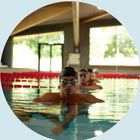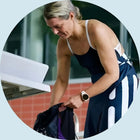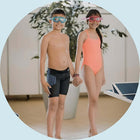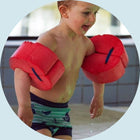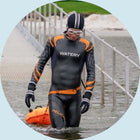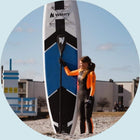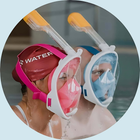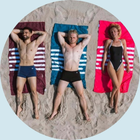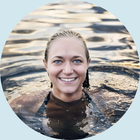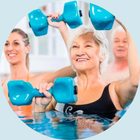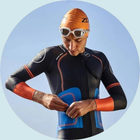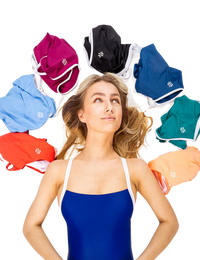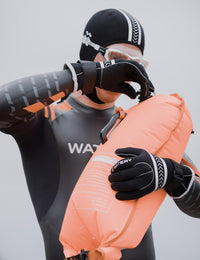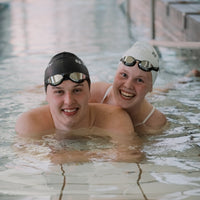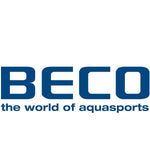What is Synchronised Swimming?
Synchronised swimming is dancing in the water, expressing yourself artistically to music. It's a fantastic and different way to move in the water and is for all water lovers, young and old. The majority of the sport's athletes are women, but more and more men are also competing in the synchronised swimming elite. The sport requires a combination of strength, agility, grace, control, coordination and fitness. As a swimmer, you have to convince your audience and judges that what you're doing is a game and not even close to being a challenge. The sport is physically demanding and it can be compared to running a sprint race without breathing.
About synchronised swimming - here in Hobro:
Synchronised swimming is a sport that develops the body and technique while providing a good workout for all muscle groups in the body.
At the higher levels, the sport places enormous demands on body control, motor skills and coordination. You are forced to use the water and your body in the right way to perform the difficult but beautiful elements of the sport.
At all levels, the sport provides a very special water sensation. A water feeling you don't get in other water sports. You exercise in a different and fun way, where you move in a completely different way than you are used to, while working with others to create beautiful patterns and acrobatic lifts. You learn to utilise the water and stay afloat without touching the bottom, as this will disqualify you from the sport.
In synchronised swimming, it is possible to compete in 4 disciplines: solo, duet, team (4-8 swimmers), and combo team (up to 10 swimmers). In solo, there is the greatest opportunity to express yourself artistically to the music and move more freely and fluidly than in the other disciplines. The other three disciplines require good co-operation and the movements have to be hit on the same beat, which is the biggest challenge.
How do you get started, what do you need and how much does it cost?
The equipment for training is very simple, all you need is a swimsuit or a pair of swim trunks, a pair of goggles, a swim cap and a nose clip. We spend a lot of time standing on our heads in the water, so a nose clip is essential. However, some people are not affected by the water on their heads, but for many it's a good idea to have one.
The price varies from club to club as each club has a different number of hours of lessons per week. A typical artistic swimming membership fee, which is comparable to a regular swim school membership fee, costs around 65€ and then the price will increase in line with the amount of training.
Synchronised swimming competitions
Once you have learnt the basic techniques and have reached beginner level, you can enter the competitions. A competition is divided into two parts, the figure competition and the music competition.
The first part of the competition is the so-called figure competition.
Here, you swim separately in front of five to six judges and show a specific element. Each swimmer will then be judged with a score from 1-10. For this part of the competition, you must wear a black swimsuit and a white swim cap so that the judges cannot clearly distinguish between the swimmers who swim in.

The second part, the so-called music competition, involves getting in the water and performing the choreography you have practised at home to music. This part is by far the toughest, as you have to perform a programme of around 3 minutes, with half of the programme taking place underwater while you work. This part of the competition involves the artistic element, where you as a swimmer have to convince the judge that your programme is the best. You are judged on three areas: difficulty, execution and artistic expression. Artistic expression is judged on your facial expression and body movements.

For the second part, the hair should be put up in a tight bun to keep the hair away from the eyes during the competition. For the bun, you will need rubber bands and hairpins. When putting the hair up, apply liquid gelatine to the hair so that it doesn't dissolve in the water. Then attach some nice hair ornaments to the hair.
Then it's time to put on your fancy swimsuit. At the beginner level, you typically borrow an embellished swimsuit from your club with either sequins or stones glued on it.
When you reach a higher level, many people choose to buy a swimsuit where they can be creative and glue or sew as they wish. Others choose to have a customised suit made by companies that exclusively produce such suits.
All professional figure swimmers have these suits sewn and this helps to score more points on the finish. Several in Ireland have also had customised suits made, and this helps to raise the level of artistic swimming in Ireland to a more professional level.
The suits are very shiny and help to give the judge an impression of your theme and thus assess your score for artistic expression better.

Lastly, make-up is also used to give the final touch to the expression and to make the facial features more visible to the judges. The judges are sitting far away, which is why the facial features need to be extra clear.
See how the best competitive synchronised swimmers in Hobro train, what equipment they use and what happens underwater:
Teamwork

The sport requires good co-operation between the swimmers on the team. The swimmers should think alike, which means that they should count the beats to the music in the same way.
The swimmers must also recognise each other's strengths and weaknesses. The unity behind a team is strongest when all swimmers know each other, and this way, there will also be a lot of support for those who need it most.
Points system
As a swimmer, you should not underestimate either the figure competition or the music competition, as both competitions count 50% towards the overall score. If you want to reach the podium and achieve the high points, you need to be both technically skilled in the figure competition and skilful at expressing yourself in the music competition.
GET A DISCOUNT CODE WITH 10% OFF
The discount code can be used by all new customers on all products on the website, including the products recommended here in the article.
What are you waiting for? Get more out of your time in and on the water!
Synchronised swimming in Denmark
In Denmark, synchronised swimming is not a widespread sport compared to many others. There are about 11 clubs, 3 in Jutland, 1 on Funen and 5 on Zealand, and about 500 swimmers nationwide. Until 2017, the sport was called "synchronised swimming", but in the summer of 2017, after the World Championships, it was decided by FINA that the sport should change its name to "artistic swimming".
On a national level, Denmark has 4-5 competitions where everyone can participate. The competitions are for all levels, and several competitions take place over a whole weekend. There's always a great atmosphere at the competitions, and it's always exciting at the end when we find out who wins the gold medals. Every year, the club of the year is announced, which is an award for the club that has scored the most points in the season's championships, i.e. DÅM/DJM and DM. The award has enormous prestige in Denmark's artistic swimming community, and many clubs are in a close race for it every year.

Every year, Denmark organises a joint training camp for all swimmers in all clubs, where an international coach is brought in. There is a lot to learn, and it's nice to meet at a national level and train in a different way with each other.
In 2016, artistic swimming in Denmark was introduced to the "Jyllandsholdet". An alternative to a national team, which the Danish Swimming Union supported. The team is aimed at Jutland's oldest swimmers who were actually thinking of retiring. The team received a lot of support and in 2017, the Jutland team had to organise an admission to the team. The Union once again supported the team and paid for both the underwater speaker and the coach's salary.
In 2018, a similar team started up in Zealand, which goes by the name "Sjællandsholdet". It is the intention of the two teams to compete against each other at national competitions.
International artistic swimming
Because the sport is as small as it is in Denmark, we don't have the same training opportunities as many other countries around the world. The lack of training time and, not least, training facilities also results in a lower level in Denmark compared to other countries.

In Denmark, we have had a few athletes who have made a name for themselves on the international stage. But the sport is constantly evolving and the level is rising every single year, making it difficult for a country like Denmark to keep up with the tough international competition, which is why we are falling behind.
However, there are several other international competitions around the world where we have had Danish participation several times over the last 15 years and even from several clubs.
- Maiken Svanholm and Marie Frandsen, Swedish Open 2015
The Danish national team had won several medals in team competitions, but after a declining number of swimmers at national level, the Danish Swimming Union decided to discontinue the national team. The clubs have therefore been forced to sponsor their own swimmers and take care of all the practicalities themselves.
We are keeping our fingers crossed for a greater spread of the sport and thus a national team again in the future.

- The Danish National Team in 2011 at the National Championships
Of course, the sport also includes major championships such as the Danish Championships, European Championships, World Championships and most recently the Olympic Games.
Is the sport called synchronised swimming, artistic swimming or water ballet?
The sport was initially called "water ballet", but after much development during the 90s, the name of the sport was changed to "synchronised swimming". Suddenly, it was no longer like ballet, moving faster in beautiful patterns and creating challenging choreographies.
In 2017, FINA decided to change the name of the sport to 'artistic swimming'. There are many opinions on the rationale behind the decision, but FINA itself believes that the sport is like figure skating. It is truly an artistic sport and you are either telling a story or trying to convey a message through choreography.
So don't be fooled by the new name, the sport is still the same, dancing in the water to music
Get started with synchronised swimming / synchronised swimming
Now you should be well prepared to get started with synchronised swimming as a sport. At least you hopefully know a bit more about the sport.
If you still think the sport sounds fun and interesting, you'll need some equipment first. We've put together a quick list here:
- A swim backpack
- A water bottle
- A regular towel
- A larger selection of regular tracksuits
- A selection of swimsuits with creative patterns and colours that can be used for music competitions. These suits can be used for gluing or sewing.
- Swim caps in different sizes, but at least one in white (logo must be visible) as this will be used for figure competitions
- All-black swimsuits (logo can be visible) for figure competitions
- Foam roller to recover better after hard workouts
- Exercise elastic bands to prevent injuries
- Nose clips
- Swim goggles
Once you've got all this, find a synchronised club near you.
Then you should be ready to give synchronised swimming a try.
If you have any questions about any of this, please leave a comment below and we'll try to answer them.
This article was written by Cecilie Højmark, who is a competitive synchronised swimmer in Hobro and has been doing the sport for several years. Thank you very much for that.
